Why Does My Child Breathe Through Their Mouth While Sleeping?

Introduction
If you have noticed your child often sleeps with their mouth open or even snores loudly, you’re not alone. Child mouth breathing during sleep is a surprisingly common concern, and while it might look harmless, it could indicate deeper issues, from nasal blockages to enlarged adenoids.
In this article, we’ll unpack the causes, symptoms, and consequences of mouth breathing in children, especially during sleep, and share what you can do as a parent to help your child breathe and sleep better.
What Is Child Mouth Breathing?
Nasal breathing is the optimal and natural way of breathing air for our body. But if a child is continuously breathing with the mouth, especially during nighttime, then something is blocking his nasal airway.
Mouth breathing can be occasional, such as when you have a cold and are ill, but chronic mouth breathing is a problem. It means your child’s body has adapted to coping with a chronic issue with nasal breathing, and that is where the real issues begin.
Common causes of child mouth breathing include:
- Enlarged adenoids or tonsils
- Nasal congestion due to allergies
- Deviated nasal septum
- Nasal polyps
- Habitual breathing pattern from early childhood
Adenoids and Tonsils: The Hidden Obstruction
What Are Adenoids?
Adenoids are embryonic lymphoid tissues that are located in the back of the throat and behind the nose. They help to catch viruses and bacteria — especially in childhood before the immune system has reached maturity.
But the issue is this: in most kids, adenoids do get enlarged, especially due to recurrent infections or allergy. And when that happens, they will occlude nasal passages partially (or even entirely), and the child will have to mouth-breathe.
Signs That Enlarged Adenoids May Be the Cause:
- Chronic mouth breathing
- Noisy breathing during sleep
- Snoring
- Frequent ear infections
- Nasal-sounding voice
- Restless sleep or night sweating
Similarly, tonsils — the tissues at the back of the throat — can also enlarge and contribute to airway obstructio
Signs of Child Mouth Breathing Parents Shouldn’t Ignore
Mouth breathing isn’t always obvious unless you’re watching your child sleep. Here are some symptoms to look out for:
- Dry mouth and chapped lips in the morning
- Frequent awakening or tossing and turning at night
- Snoring or sleep apnea episodes
- Fatigue or irritability during the day
- Open-mouthed posture during the day
- Dark circles under the eyes (a sign of poor sleep)
Long-Term Effects
- Dental and Orthodontic Problems
- Facial Development
The facial bones grow around the breathing pattern. Chronic mouth breathing can lead to a long, narrow face and underdeveloped jaw.
- Cognitive and Behavioral Issues
Sleep fragmentation due to mouth breathing can affect focus, memory, and mood. In some cases, it’s even misdiagnosed as ADHD.
- Increased Risk of Infections
Diagnosis: What to Expect from the Pediatric ENT
If you suspect your child is a chronic mouth breather, especially during sleep, the best step is to consult a pediatric ENT (ear-nose-throat) specialist.
Diagnostic Tools May Include:
Endoscopy: A small camera checks the nasal passages and throat.- X-rays or lateral neck radiographs: Help visualize enlarged adenoids.
- Sleep study (polysomnography): In severe cases, to check for sleep apnea.
Treatment Options for Child Mouth Breathing in Ahmedabad
Once the cause is identified, treatment options vary:
1. Medical Treatment
If allergies are the culprit, pediatricians may recommend:
- Nasal corticosteroid sprays
- Antihistamines
- Decongestants
- Saline nasal rinses
2. Surgical Treatment
In cases of enlarged adenoids or tonsils, a minor outpatient surgery may be advised:
- Adenoidectomy: Removal of the adenoids
- Tonsillectomy: Removal of the tonsils
- Adenotonsillectomy: Removal of both
These surgeries are common, safe, and significantly improve breathing and sleep quality in most children.
What Parents Can Do at Home
Even if you’re waiting for an appointment, there are a few things you can do to help your child breathe more comfortably:
- Use a cool-mist humidifier in the bedroom
- Elevate the head during sleep with a small pillow
- Keep the bedroom dust-free to avoid allergens
- Encourage nasal breathing exercises during the day
- Avoid letting your child sleep on their back if snoring is severe
